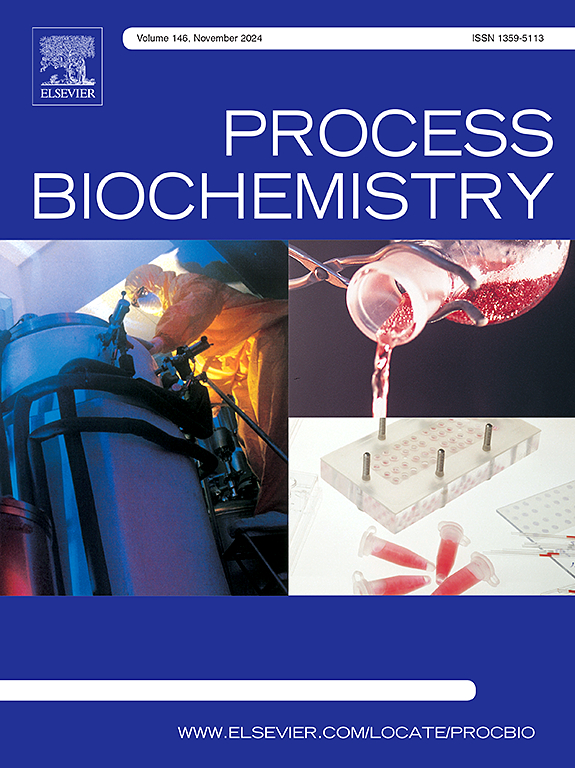拉克酶介导的氯唑嗪低聚物合成:深入了解反应条件的影响并评估低聚物的生物活性
IF 3.7
3区 生物学
Q2 BIOCHEMISTRY & MOLECULAR BIOLOGY
引用次数: 0
摘要
研究了关键实验因素对Trametes versicolor漆酶催化氯啶嗪低聚作用的影响,并对合成的低聚物的生物活性进行了评估。对所得反应混合物的质谱分析表明,存在聚合度为 2 和 3 的低聚物,二聚物是主要产物。所形成的低聚物的质量检测结果表明,它们的结构中存在重复的氯啶单元,并且在连接形成过程中失去了两个氢原子,而主要二聚物的核磁共振分析则证实存在两个通过 C5-C5 键连接的氯啶分子。研究了温度、底物和酶的浓度对杀螟丹转化率和产品收率的影响,要获得最高的产品收率(4.1 毫克/毫升),最佳温度为 40 °C,杀螟丹浓度为 5 毫克/毫升,漆酶浓度为 0.5 毫克/毫升。合成的低聚物显示出了比氟啶嗪更强的抗氧化活性,而且在广泛的测试浓度范围内对机会致病菌金黄色葡萄球菌有抑制作用,对共生菌表皮葡萄球菌有刺激作用,因此具有很好的用作皮肤益生元的潜力。在表皮葡萄球菌和金黄色葡萄球菌的联合培养中,0.0195 毫克/毫升的浓度表现出最高的益生能力。本文章由计算机程序翻译,如有差异,请以英文原文为准。
Laccase-mediated synthesis of phloridzin oligomers: An insight into the influence of reaction conditions and evaluation of oligomers’ biological activity
The effect of key experimental factors on phloridzin oligomerization catalyzed by Trametes versicolor laccase was investigated, and biological activity of synthesized oligomers was evaluated. Mass spectrometry analysis of the obtained reaction mixture showed the presence of oligomers with the degrees of polymerization two and three with dimer as the major product. The detected masses of the formed oligomers indicated the repetition of phloridzin units in their structure and the loss of two hydrogen atoms during the linkage formation, while NMR analysis of the major dimer confirmed the presence of two phloridzin molecules linked via a C5-C5 bond. The effect of temperature, substrate, and enzyme concentration on phloridzin conversion and products’ yield was examined, and for achieving the highest products yield (4.1 mg/ml), optimal factors were 40 °C temperature, 5 mg/ml phloridzin concentration and 0.5 mg/ml laccase concentration. Synthesized oligomers showed good antioxidant activity compared to phloridzin and very good potential to be used as skin prebiotics since they exhibited inhibitory effect on opportunistic pathogen Staphylococcus aureus and stimulating effect on commensal bacteria Staphylococcus epidermidis in a broad range of tested concentrations. The highest prebiotic capacity was demonstrated at a concentration of 0.0195 mg/ml in S. epidermidis and S. aureus co-culture.
求助全文
通过发布文献求助,成功后即可免费获取论文全文。
去求助
来源期刊

Process Biochemistry
生物-工程:化工
CiteScore
8.30
自引率
4.50%
发文量
374
审稿时长
53 days
期刊介绍:
Process Biochemistry is an application-orientated research journal devoted to reporting advances with originality and novelty, in the science and technology of the processes involving bioactive molecules and living organisms. These processes concern the production of useful metabolites or materials, or the removal of toxic compounds using tools and methods of current biology and engineering. Its main areas of interest include novel bioprocesses and enabling technologies (such as nanobiotechnology, tissue engineering, directed evolution, metabolic engineering, systems biology, and synthetic biology) applicable in food (nutraceutical), healthcare (medical, pharmaceutical, cosmetic), energy (biofuels), environmental, and biorefinery industries and their underlying biological and engineering principles.
 求助内容:
求助内容: 应助结果提醒方式:
应助结果提醒方式:


